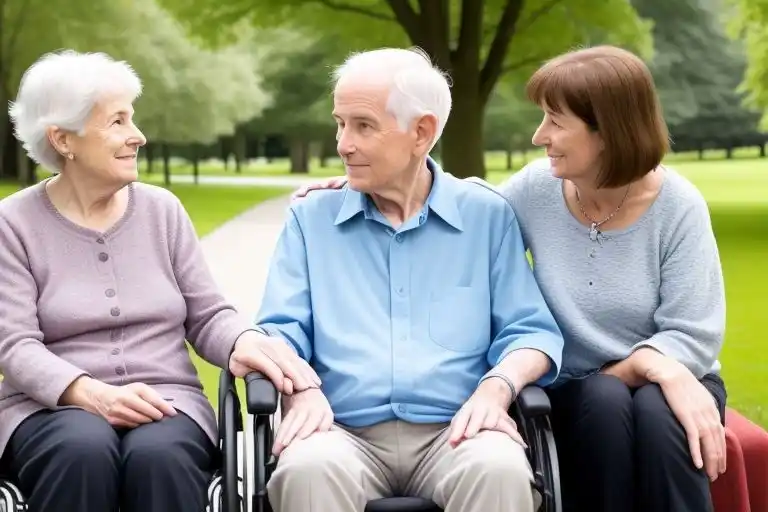
Navigating Parkinson’s Disease: An In-Depth Look at Causes, Symptoms, and Management Strategies
Parkinson’s disease (PD) is a progressive neurological disorder that affects millions of people worldwide. While the exact cause remains unknown, significant advancements in research have shed light on the mechanisms behind its development, symptoms, and potential treatments. In this article, we will delve into the multifaceted aspects of Parkinson’s disease, providing a comprehensive overview of its generation, symptoms, precautions, treatments, lifestyle modifications, and natural remedies. We will also explore some enlightening case studies to offer a deeper understanding of the lived experiences of those affected by PD.
Understanding Parkinson’s Disease
Parkinson’s disease is characterized by the degeneration of dopamine-producing neurons in the substantia nigra, a region of the brain. This loss of dopamine leads to a variety of motor and non-motor symptoms, significantly impacting the quality of life for patients. The disease typically progresses slowly over many years, with the severity of symptoms increasing over time.
Generation of Parkinson’s Disease
The exact cause of Parkinson’s disease is still a subject of extensive research. However, scientists have identified several factors that may contribute to its development:
- Genetics: Approximately 10-15% of PD cases are familial, meaning they are linked to specific genetic mutations. The most common genes associated with PD include SNCA, LRRK2, and PINK1.
- Environmental Factors: Exposure to certain toxins, such as pesticides and heavy metals, has been linked to an increased risk of PD. Traumatic brain injuries and viral infections may also play a role.
- Age: The risk of developing PD increases with age, with the majority of cases occurring in individuals over 60.
- Gender: Men are more likely to develop PD than women, although the reason for this gender disparity is not fully understood.
Symptoms of Parkinson’s Disease
Parkinson’s disease manifests through a wide range of symptoms, which can be broadly categorized into motor and non-motor symptoms.
Motor Symptoms
- Tremor: Typically begins in the hands or arms and can spread to the legs and head.
- Rigidity: Stiffness in the muscles, which can limit range of motion and cause pain.
- Bradykinesia: Slowness of movement, making everyday tasks more challenging.
- Postural Instability: Difficulty maintaining balance and coordination, leading to an increased risk of falls.
Non-Motor Symptoms
- Cognitive Impairment: Including memory loss, difficulty concentrating, and executive function deficits.
- Mood Disorders: Depression and anxiety are common among PD patients.
- Sleep Disorders: Insomnia, REM sleep behavior disorder, and excessive daytime sleepiness.
- Autonomic Dysfunction: Issues with blood pressure, digestion, and bladder control.
- Sensory Problems: Loss of smell, vision changes, and skin sensitivity.
Precautions and Risk Reduction
While Parkinson’s disease cannot be prevented, certain precautions can help reduce the risk or delay its onset:
- Healthy Lifestyle: Maintaining a balanced diet, regular exercise, and adequate sleep can support overall brain health.
- Avoiding Toxins: Minimizing exposure to pesticides, heavy metals, and other environmental toxins can lower the risk.
- Head Injury Prevention: Wearing helmets and taking safety precautions to prevent head injuries can be beneficial.
- Genetic Counseling: Individuals with a family history of PD may benefit from genetic counseling to understand their risk and take proactive steps.
Treatment Options
The management of Parkinson’s disease is multifaceted, involving pharmacological, surgical, and lifestyle interventions. The goal is to alleviate symptoms, improve quality of life, and slow disease progression.
Pharmacological Treatments
- Levodopa: The most effective medication for managing motor symptoms. It is converted into dopamine in the brain.
- Dopamine Agonists: These drugs mimic the effects of dopamine and can be used alone or in combination with levodopa.
- Monoamine Oxidase B (MAO-B) Inhibitors: Help prevent the breakdown of dopamine in the brain.
- Catechol-O-Methyltransferase (COMT) Inhibitors: Extend the effectiveness of levodopa by preventing its breakdown.
- Anticholinergics: Used to manage tremors and muscle stiffness.
Surgical Interventions
- Deep Brain Stimulation (DBS): Electrodes are implanted in specific areas of the brain to regulate abnormal neural activity. DBS can significantly reduce motor symptoms in advanced PD.
- Lesioning Procedures: Involves creating lesions in specific brain areas to disrupt the circuits responsible for PD symptoms. This is less commonly used due to the advent of DBS.
Lifestyle Modifications
- Exercise: Regular physical activity, such as walking, swimming, and yoga, can improve mobility, balance, and overall well-being.
- Physical Therapy: Tailored exercises and techniques to enhance motor function and reduce muscle stiffness.
- Occupational Therapy: Strategies to adapt daily activities and improve independence.
- Speech Therapy: Techniques to address voice and speech issues, common in PD patients.
Natural Remedies
- Dietary Supplements: Certain supplements, such as coenzyme Q10 and vitamin D, may have neuroprotective benefits.
- Herbal Remedies: Ginkgo biloba and green tea have been studied for their potential to support brain health.
- Mind-Body Practices: Meditation, tai chi, and mindfulness can help manage stress and improve mental health.
Case Studies
Case Study 1: John’s Journey
John, a 65-year-old retired teacher, was diagnosed with Parkinson’s disease five years ago. He initially experienced a tremor in his right hand, which gradually spread to his leg and arm. John’s doctor prescribed a combination of levodopa and a dopamine agonist, which helped manage his motor symptoms. He also started a regular exercise routine, including swimming and yoga, which improved his balance and flexibility. John’s case highlights the importance of a holistic approach to managing PD, combining medication with lifestyle interventions.
Case Study 2: Maria’s Experience
Maria, a 57-year-old graphic designer, was diagnosed with Parkinson’s disease after experiencing bradykinesia and rigidity. She decided to explore natural remedies alongside her prescribed medication. Maria began a regimen of coenzyme Q10 and vitamin D supplements, and she also started practicing mindfulness meditation. Over time, she noticed a reduction in her anxiety and an improvement in her cognitive function. Maria’s story underscores the potential benefits of complementary therapies in PD management.
Case Study 3: David’s Surgical Intervention
David, a 62-year-old engineer, had been living with Parkinson’s disease for a decade. Despite taking multiple medications, his symptoms had become severe, including frequent falls and significant bradykinesia. After consulting with his neurologist, David underwent deep brain stimulation (DBS) surgery. The procedure was successful, and David experienced a dramatic reduction in his motor symptoms. He now leads a more active life and has resumed many of his hobbies. David’s case demonstrates the effectiveness of surgical interventions in advanced PD.
Conclusion
Parkinson’s disease is a complex and multifaceted condition that requires a comprehensive approach to management. From understanding the underlying mechanisms to exploring a range of treatment options, including pharmacological, surgical, and lifestyle interventions, there are many avenues for improving the quality of life for those affected by PD. Natural remedies and complementary therapies can also play a supportive role in symptom management and overall well-being.
As we continue to advance our knowledge of PD, it is crucial for patients, caregivers, and healthcare providers to stay informed about the latest developments. By combining medical expertise with patient-centered care, we can make significant strides in the battle against Parkinson’s disease.
Relevant Quotation
“The best way to find yourself is to lose yourself in the service of others.” — Mahatma Gandhi
While this quote is not directly related to Parkinson’s disease, it resonates with the spirit of community and support that can be vital for those living with PD. Engaging in activities that bring purpose and connection can have a profound impact on mental health and overall well-being.
Tables
Table 1: Common Medications for Parkinson’s Disease
| Medication Type | Examples | Mechanism of Action | Common Side Effects |
| Dopamine Precursors | Levodopa | Converted to dopamine in the brain | Nausea, dyskinesia, low blood pressure |
| Dopamine Agonists | Pramipexole, Ropinirole | Mimics dopamine effects | Hallucinations, dizziness, sleepiness |
| MAO-B Inhibitors | Rasagiline, Selegiline | Prevents dopamine breakdown | Headache, insomnia, nausea |
| COMT Inhibitors | Entacapone, Tolcapone | Extends levodopa’s effect | Diarrhea, abdominal pain, vivid dreams |
| Anticholinergics | Trihexyphenidyl, Benztropine | Reduces muscle stiffness | Dry mouth, confusion, constipation |
Table 2: Lifestyle Modifications for Parkinson’s Disease
| Modification | Benefits | Practical Tips |
| Regular Exercise | Improves mobility, balance, and overall well-being | Engage in activities like walking, swimming, and yoga |
| Physical Therapy | Enhances motor function and reduces muscle stiffness | Work with a physical therapist to develop a tailored exercise plan |
| Occupational Therapy | Improves independence in daily activities | Use adaptive tools and techniques to make tasks easier |
| Speech Therapy | Addresses voice and speech issues | Practice vocal exercises and communication strategies |
| Mind-Body Practices | Reduces stress and improves mental health | Try meditation, tai chi, and mindfulness |
By adopting a multidisciplinary approach and staying informed about the latest research, we can better navigate the challenges of Parkinson’s disease and support those affected by this condition.
FAQs
1. What is Parkinson’s Disease?
Answer: Parkinson’s Disease (PD) is a progressive neurological disorder that affects movement. It develops gradually, sometimes starting with a barely noticeable tremor in one hand. The disorder also commonly causes stiffness or slowing of movement and can lead to a variety of non-motor symptoms as well.
2. What causes Parkinson’s Disease?
Answer: The exact cause of Parkinson’s Disease is unknown, but it involves the loss of dopamine-producing neurons in the brain. Genetic factors, environmental toxins, and oxidative stress are believed to play a role. Age, gender, and family history can also influence the risk of developing PD.
3. What are the primary symptoms of Parkinson’s Disease?
Answer: The primary symptoms of Parkinson’s Disease include:
- Tremor: Shaking, often starting in a limb, especially the hand or fingers.
- Rigidity: Stiffness or inflexibility of the limbs and trunk.
- Bradykinesia: Slowness of movement.
- Postural Instability: Impaired balance and coordination.
4. Are there any non-motor symptoms associated with Parkinson’s Disease?
Answer: Yes, non-motor symptoms can be just as significant and may include:
- Cognitive changes: Such as memory problems and slowed thinking.
- Mood disorders: Like depression and anxiety.
- Sleep problems: Including insomnia and restless leg syndrome.
- Fatigue: Persistent tiredness.
- Autonomic dysfunction: Issues with blood pressure, bladder control, and constipation.
5. How is Parkinson’s Disease diagnosed?
Answer: Parkinson’s Disease is diagnosed primarily through a neurological examination and observation of symptoms. There is no specific test for PD, but doctors may use various assessments, including:
- Medical history: Reviewing the patient’s symptoms and family history.
- Physical examination: Checking for tremor, rigidity, and bradykinesia.
- Neurological tests: Assessing balance, coordination, and reflexes.
- Imaging studies: Such as MRI or PET scans to rule out other conditions.
6. Is Parkinson’s Disease curable?
Answer: Currently, there is no cure for Parkinson’s Disease. However, there are effective treatments that can manage symptoms and improve quality of life. These include medications, physical therapy, and surgical interventions.
7. What are the main medications used to treat Parkinson’s Disease?
Answer: The most common medications for Parkinson’s Disease include:
- Levodopa (L-DOPA): Converts into dopamine in the brain, helping to alleviate symptoms.
- Dopamine agonists: Mimic the effects of dopamine in the brain.
- MAO-B inhibitors: Prevent the breakdown of dopamine.
- COMT inhibitors: Extend the effects of levodopa.
- Anticholinergics: Help control tremors.
8. Can lifestyle changes help manage Parkinson’s Disease?
Answer: Yes, lifestyle changes can significantly help manage Parkinson’s Disease. These include:
- Exercise: Regular physical activity can improve mobility and balance.
- Diet: A balanced diet rich in fruits, vegetables, and lean proteins can support overall health.
- Stress management: Techniques like meditation, yoga, and deep breathing can reduce stress and improve mental well-being.
- Support groups: Connecting with others who have PD can provide emotional support and practical advice.
9. What is Deep Brain Stimulation (DBS) and how does it help?
Answer: Deep Brain Stimulation (DBS) is a surgical procedure where a device called a neurostimulator is implanted to deliver electrical impulses to specific areas of the brain. This can help reduce motor symptoms, especially in advanced PD. DBS is most effective for patients who respond well to levodopa but experience significant fluctuations in symptom control.
10. How does Parkinson’s Disease progress over time?
Answer: Parkinson’s Disease is a progressive condition, meaning symptoms worsen over time. The rate of progression varies among individuals, but typically:
- Early stage: Mild symptoms that do not interfere significantly with daily activities.
- Mid-stage: Symptoms become more pronounced and may affect daily life.
- Advanced stage: Severe symptoms that require significant assistance with daily activities.
11. Can Parkinson’s Disease be prevented?
Answer: There is no known way to prevent Parkinson’s Disease. However, some studies suggest that certain factors like regular exercise, a healthy diet, and avoiding exposure to environmental toxins may reduce the risk. Early diagnosis and treatment can also help manage symptoms and slow the progression of the disease.
12. What are the potential side effects of Parkinson’s medications?
Answer: Parkinson’s medications can have side effects, which may include:
- Nausea and vomiting
- Dizziness and low blood pressure
- Hallucinations and delusions
- Dyskinesia (involuntary movements)
- Insomnia and sleep disturbances
13. How can caregivers support a person with Parkinson’s Disease?
Answer: Caregivers can support a person with Parkinson’s Disease by:
- Encouraging regular exercise and physical therapy.
- Assisting with daily activities as needed.
- Providing emotional support and encouragement.
- Helping manage medication schedules.
- Facilitating communication with healthcare providers.
14. Are there any clinical trials for Parkinson’s Disease?
Answer: Yes, there are ongoing clinical trials for Parkinson’s Disease that aim to develop new treatments, improve existing ones, and better understand the disease. Patients interested in participating should consult their healthcare provider or visit clinical trial databases for more information.
15. What resources are available for people with Parkinson’s Disease and their families?
Answer: Several resources are available to support people with Parkinson’s Disease and their families:
- Parkinson’s Foundation: Offers educational materials, support groups, and a helpline.
- Michael J. Fox Foundation: Focuses on research and provides resources for living with PD.
- National Parkinson Foundation: Provides information on treatment, support, and research.
- Local support groups: Offer a community of understanding and shared experiences.
16. What is the role of physical therapy in managing Parkinson’s Disease?
Answer: Physical therapy can help manage Parkinson’s Disease by:
- Improving mobility and flexibility.
- Strengthening muscles and enhancing balance.
- Reducing the risk of falls.
- Customizing exercise programs to individual needs.
17. How can speech therapy benefit someone with Parkinson’s Disease?
Answer: Speech therapy can benefit people with Parkinson’s Disease by:
- Improving clarity of speech.
- Enhancing volume and projection.
- Addressing swallowing difficulties.
- Providing strategies to communicate more effectively.
18. What are some research advancements in Parkinson’s Disease?
Answer: Recent research advancements in Parkinson’s Disease include:
- Gene therapies: Targeting specific genes to slow or stop disease progression.
- Stem cell treatments: Using stem cells to replace damaged neurons.
- Neuroprotective drugs: Investigating medications that may protect dopamine-producing neurons.
- Wearable technology: Devices that monitor symptoms and provide real-time data to adjust treatments.
19. How can family and friends help someone with Parkinson’s Disease?
Answer: Family and friends can help by:
- Educating themselves about PD.
- Providing emotional support and encouragement.
- Assisting with practical tasks when needed.
- Encouraging participation in support groups and community activities.
- Helping with transportation to medical appointments.
20. What is the importance of a multidisciplinary approach in managing Parkinson’s Disease?
Answer: A multidisciplinary approach is crucial in managing Parkinson’s Disease as it involves various healthcare professionals working together to address all aspects of the condition. This team may include neurologists, physical therapists, occupational therapists, speech therapists, and mental health professionals. Each specialist contributes to a comprehensive treatment plan that addresses motor and non-motor symptoms, ensuring the best possible quality of life for the patient.
These FAQs provide a comprehensive overview of Parkinson’s Disease, covering its causes, symptoms, and management strategies. If you have more specific questions or need further information, consult a healthcare professional or a Parkinson’s Disease specialist.
Medical Disclaimer:
The information provided on this website is for general educational and informational purposes only and is not intended as a substitute for professional medical advice, diagnosis, or treatment. Always seek the advice of your physician or other qualified health provider with any questions you may have regarding a medical condition. Never disregard professional medical advice or delay in seeking it because of something you have read on this website.



